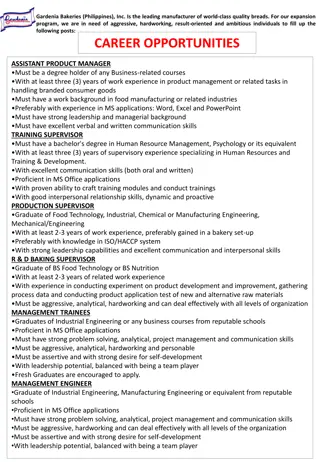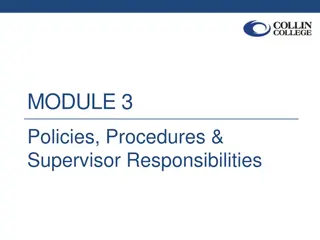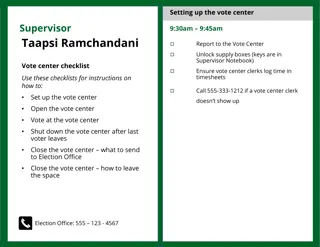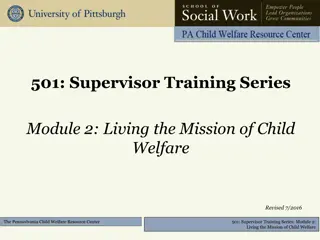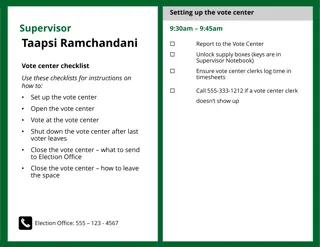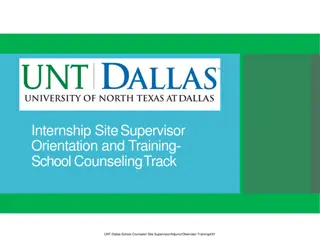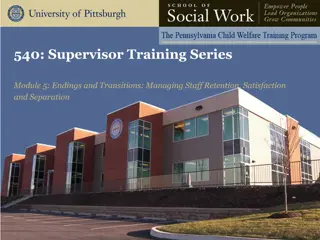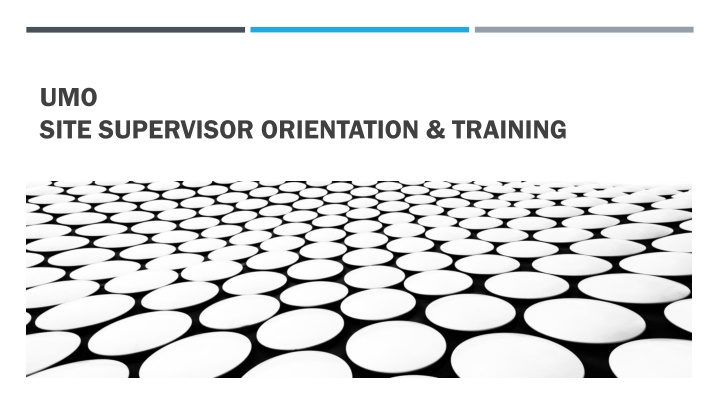
Clinical Supervision Training for Site Supervisors in Mental Health Program
Enhance your knowledge and skills as a site supervisor in the Clinical Mental Health Program with training and orientation sessions focusing on professional practice, standards, and ethical considerations. Explore the role of clinical supervision, learning objectives, and expectations for counseling supervisors.
Download Presentation

Please find below an Image/Link to download the presentation.
The content on the website is provided AS IS for your information and personal use only. It may not be sold, licensed, or shared on other websites without obtaining consent from the author. If you encounter any issues during the download, it is possible that the publisher has removed the file from their server.
You are allowed to download the files provided on this website for personal or commercial use, subject to the condition that they are used lawfully. All files are the property of their respective owners.
The content on the website is provided AS IS for your information and personal use only. It may not be sold, licensed, or shared on other websites without obtaining consent from the author.
E N D
Presentation Transcript
UMO SITE SUPERVISOR ORIENTATION & TRAINING
WELCOME AND THANK YOU On behalf of UMO faculty and students in the Clinical Mental Health Program, thank you for your commitment to the development and growth of our practicum and internship students. Your willingness to share your time, and expertise to assist in the development of counselors-in-training is deeply appreciated.
RATIONALE FOR SITE SUPERVISOR ORIENTATION AND TRAINING CACREP 2016 Standards: Section 3: Professional Practice CACREP 2016 Standards: Section 3: Professional Practice P. Site supervisors have (1) a minimum of a master s degree, preferably in counseling, or a related profession; P. Site supervisors have (1) a minimum of a master s degree, preferably in counseling, or a related profession; (2) relevant certifications and/or licenses; (3) a minimum of two years of pertinent professional experience in the (2) relevant certifications and/or licenses; (3) a minimum of two years of pertinent professional experience in the specialty area in which the student is enrolled; (4) knowledge of the program s expectations, requirements, and specialty area in which the student is enrolled; (4) knowledge of the program s expectations, requirements, and evaluation procedures for students; and (5) relevant training in counseling supervision. evaluation procedures for students; and (5) relevant training in counseling supervision. Q. Orientation, consultation, and professional development opportunities are provided by counselor education Q. Orientation, consultation, and professional development opportunities are provided by counselor education program faculty to site supervisors. program faculty to site supervisors.
SITE SUPERVISOR ORIENTATION & TRAINING LEARNING OBJECTIVES (1) Define clinical supervision. (2) Review qualifications for site supervisors. (3) Review desired attributes of supervisors and supervisees. (4) Identify the developmental stages of counselors-in-training. (5) Review examples of clinical supervision models. (6) Understand the role of clinical supervisor. (7) Explore examples of supervision session structure and possible topics that might present in supervision. (8) Review ethical considerations of supervision (ACA Code of Ethics)
INTRODUCTION TO SUPERVISION What is clinical supervision? What is clinical supervision? An intervention that is provided by a senior member of a profession to a junior member, or members of the same profession. The relationship is evaluative, extends over time, and has simultaneous purpose of enhancing the professional functioning of the junior member(s), monitoring the quality of professional services offered to the clients, and serving as a gatekeeper to those who are to enter the particular profession. (Bernard, & Goodyear, 2014)
EXPECTATIONS Clinical Mental Health Program students are required to complete a 100 hour experience typically is completed in one semester. Students must complete 40 direct counseling hours indirect counseling hours. indirect counseling hours. 100 hour- -practicum site experience practicum site experience. This field 40 direct counseling hours and 60 60 Clinical Mental Health Program students are required to complete a 600 hour must complete 240 direct counseling hours 240 direct counseling hours and 360 indirect counseling hours 600 hour- -internship site experience internship site experience. Students 360 indirect counseling hours. Clinical Mental Health Program students must receive 1.5 hours of weekly group supervision client sessions. This is an expectation for both practicum and internship. 1.5 hours of weekly group supervision in which they process Clinical Mental Health Program students must receive 1 hour of individual/triadic supervision 1 hour of individual/triadic supervision. You and the student will sign a Practicum/Internship Agreement Practicum/Internship Agreement which is a contract that states the expectations and roles for both the site supervisor and practicum/internship student.
CLINICAL MENTAL HEALTH PRACTICUM AND INTERNSHIP Practicum Practicum Typically one semester in length. Practicum is a 100 hour-practicum site experience. Students must complete 40 direct counseling hours and 60 indirect counseling hours. Students must receive a minimum of one hour of individual/triadic supervision from a university supervisor. Students must receive a minimum of one and a half hours of group supervision each week. This class meets from 6:00 to 7:30 on Mondays each semester in Zoom. Internship Typically two semesters in length. Internship is a 600 hour-internship site experience. Students must complete 240 direct counseling hours and 360 indirect counseling hours Students must receive one hour of site supervisor supervision each week. Students must receive a minimum of one and a half hours of group supervision each week. This class meets weekly via zoom each semester.
CHARACTERISTICS OF EFFECTIVE SUPERVISORS Characteristics Characteristics Skills Skills Self-reflective Provides feedback Open to feedback Provides encouragement Application of theory to practice. Provides support. Knowledge of supervision models/techniques. Models skills/professionalism.
PREFERRED SUPERVISEE ATTRIBUTES Takes responsibility for the consequences of one s own behavior. Willingness to grow. Actively participates in supervision sessions. Understanding of self and how that is related to both therapy and supervision. Respect and appreciation for individual differences. Stoltenberg, McNeill, & Delworth (1998)
STAGES OF SUPERVISION (LITTRELL, LEE-BORDON, & LORENZ, 1979) 1. Orientation 2. Working Stage 3. Transition Stage 4. Integration Stage
ORIENTATION During this stage: The supervisor/supervisee relationship is formed. The supervisee initiates the practicum/internship agreement and learns about agency policies, expectations, and procedures. The supervisor takes on the teacher and counselor roles by providing orientation and modeling.
WORKING STAGE During this stage: The supervisee begins initial work with clients and continues to learn about site policies, expectations, and procedures. During this stage, the supervisee will likely strengthen counseling skills, and begin to learn new interventions/strategies to use. The supervisor assesses supervisees abilities and takes note of strengths and weaknesses. The supervisor supports the supervisee with structure, resources, and support. The supervisor act in the roles of both teacher and counselor at times.
TRANSITION STAGE During this stage: The supervisee will see an increase in confidence related to counseling skills. Awareness of self and others will increase for the supervisee as well. The supervisee will being to assert more independence and begin come up with options or suggestions for interventions instead of always looking to the supervisor for answers. The supervisor encourages the supervisee to assert more independence. The supervisor begins to move into the consultant role at this stage.
INTEGRATION STAGE During this stage: This stage may not be achieved by the supervisee until after graduation and entrance into the counseling profession. Those who attain this stage as a counselor have well-developed counseling skills. The supervisor at this stage will sometimes be in the role of counselor and teacher, but the most significant role will likely be that of consultant. This relationship may move toward being more of a partnership. It is highly unlikely practicum or internship students will attain this stage of development.
EXAMPLES OF THEORETICAL MODELS The following slides will provide examples of theoretical supervision models to guide your practice as a clinical supervisor.
INTEGRATED DEVELOPMENTAL MODEL (STOLTENBERG, MCNEILL, & DELWORTH, 1998; STOLTENBERG, & MCNEILL, 2010) The Integrated Developmental Model (IDM) is likely the most widely used stage development model of supervision. It is a four-stage model that is the integration of two other models, The Integrated Developmental Model s four stages are characterized by changes in three areas that provide markers for assessing a counselor s professional growth. The chart on the next slide outlines these stages.
INTEGRATIVE DEVELOPMENT MODEL SUPERVISEE STAGES OF DEVELOPMENT (STOLTENBERG, & DELWORTH, 1997; STOLTENBERG, & MCNEILL, 2010) Stage Stage Developmental Characteristics of Supervisee Developmental Characteristics of Supervisee Level 1 Minimal self-awareness, High Anxiety Follows the lead of site supervisor Overly focused on what he or she is doing. Level 2 Becomes more independent. May become overly confident. Increased focus on the client. May be at odds with supervisor (adolescent like behavior). Level 3 Focuses on client while being able to attend to personal reactions/responses. Makes decisions about the client. Increased confidence and lessened anxiety. Level 3i Personal style of counseling emerges and supervisee has reached level three across multiple domains. High level of self-awareness related to personal competence.
SOLUTION-FOCUSED SUPERVISION (SFS) (MOLMAR, & DE SHAZER, 1987) Solution-Focused Supervision is based on Solution-Focused Counseling Theory Which is grounded in the following assumption: 1. Clients know what they want. 2. There is no single correct way to view things. 3. It is important to focus on what is possible and changeable. 4. Curiosity is essential. The next slide provides the Seven components of Solution-Focused Supervision.
SEVEN COMPONENTS OF SFS (HSU, 2009) 1. A positive opening followed by a problem description. Identifying positive supervision goals. 2. Exploring exceptions for both supervisees and clients. 3. Developing other possibilities by discussing hypothetical situations with the superivsee s and also considering the embedded meaning in supervisee s worries about clients. 4. Providing clinical education and feedback. 5. Assisting the supervisee in forming the first step for their upcoming counseling session. 6. Following up in subsequent supervision meetings about changes that occurred for both the client and the supervisee. 7.
THE DISCRIMINATION MODEL (DM) BERNARD (1979; 1997) Bernard s Discrimination Model addresses three different foci for supervision as well as three supervisor roles. Supervisors might focus on any or all of the following skills: intervention, conceptualization, and personalization. Once the site supervisor decides where the supervisee is developmentally as a counselor-in-training, the next step is to choose which supervisor role works best to fit supervision goals. These roles are: teacher, counselor, and consultant.
ROLES OF A COUNSELING SITE SUPERVISOR (BERNARD, 1979) Supervision Roles Continued Supervision Roles Continued Consultant Encourage supervisee to explore interventions to use in sessions. Collaborate with supervisee to conceptualize treatment planning. Evaluator Evaluation is an ongoing process throughout the clinical experience to support the supervisee s development (see evaluation items in the Tevera guide.) Provide both formal and informal evaluation to practicum the supervisee. How can you use the evaluation piece to increase student self-awareness and growth?
ROLES OF A COUNSELING SITE SUPERVISOR Supervision Roles Supervision Roles Teacher Provide instruction. Demonstrate/model intervention models and client case conceptualization. Explain rationale for use of specific interventions and strategies. Provide orientation to site and site expectations. Counselor Explore feelings of supervisees during supervision sessions. Facilitate supervisees exploration of fears, and anxiety related to counseling skills. Challenge supervisee to have an awareness of self and others. Enhance client curiosity and experiential learning.
EXAMPLE OF SUPERVISION IN PRACTICE Eight Steps of Clinical Supervision Eight Steps of Clinical Supervision Check in with Supervisee to see how he or she is doing. 1. Agree to work together. 2. Define and agree on learning goals. 3. Understand the value of each goal. 4. Break goals into manageable parts. 5. Discuss styles and methods of learning. 6. Observe and evaluate 7,Provide Feedback 8. Demonstrate competency/celebrate growth.
SUPERVISION SESSIONS Examples of Possible Supervision Topics Covered Have supervisee provide information about client case (presenting concerns, history, information about client. Discuss the counseling plan in development for clients: Collaborate with supervisee related to assessment, diagnosis, goal setting, and treatment planning. Discuss supervisee use of skills, strategies, and interventions to support client goals. Process the supervisee s self-awareness and thoughts and feelings related to the client. Process the supervisee s feelings about self and development of counseling skills, and cultural considerations. Evaluate the supervisees ability to self-assess and self-reflect related to work with clients and provide feedback. Evaluate and provide feedback about supervisees strengths and areas in need of improvement. Assist with planning for future sessions and treatment planning.
COUNSELOR SUPERVISION AND WELFARE OF CLIENTS (ACA CODE OF ETHICS, 2014) F.1.a. Client Welfare F.1.a. Client Welfare - A primary obligation of counseling supervisors is to monitor the services provided by supervisees. Counseling supervisors monitor client welfare and supervisee performance and professional development. To fulfill these obligations, supervisors meet regularly with supervisees to review the supervisees work and help them become prepared to serve a range of diverse clients. Supervisees have a responsibility to understand and follow the ACA Code of Ethics. F.1.b. Counselor Credentials F.1.b. Counselor Credentials - Counseling supervisors work to ensure that supervisees communicate their qualifications to render services to their clients. F.1.c. Informed Consent and Client Rights F.1.c. Informed Consent and Client Rights - Supervisors make supervisees aware of client rights, including the protection of client privacy and confidentiality in the counseling relationship. Supervisees provide clients with professional disclosure information and inform them of how the supervision process influences the limits of confidentiality. Supervisees make clients aware of who will have access to records of the counseling relationship and how these records will be stored, transmitted, or otherwise reviewed.
SUPERVISORY RELATIONSHIP (ACA CODE OF ETHICS, 2014) F.3.a Extending Conventional Supervisory Relationships - Counseling supervisors clearly define and maintain ethical professional, personal, and social relationships with their supervisees. Supervisors consider the risks and benefits of extending current supervisory relationships in any form beyond conventional parameters. In extending these boundaries, supervisors take appropriate professional precautions to ensure that judgment is not impaired and that no harm occurs. F.3.b. Sexual Relationships - Sexual or romantic interactions or relationships with current supervisees are prohibited. This prohibition applies to both in-person and electronic interactions or relationships F.3.c. Sexual Harassment - Counseling supervisors do not condone or subject supervisees to sexual harassment. F.3.d. Friends or Family Members - Supervisors are prohibited from engaging in supervisory relationships with individuals with whom they have an inability to remain objective.
RESPONSIBILITIES OF SUPERVISION (ACA CODE OF ETHICS, 2014) F.4.a. Informed Consent for Supervision - Supervisors are responsible for incorporating into their supervision the principles of informed consent and participation. Supervisors inform supervisees of the policies and procedures to which supervisors are to adhere and the mechanisms for due process appeal of individual supervisor actions. The issues unique to the use of distance supervision are to be included in the documentation as necessary F.4.b. Emergencies and Absences - Supervisors establish and communicate to supervisees procedures for contacting supervisors or, in their absence, alternative on-call supervisors to assist in handling crises. F.4.c. Standards for Supervisees - Supervisors make their supervisees aware of professional and ethical standards and legal responsibilities. F.4.d. Termination of the Supervisory Relationship - Supervisors or supervisees have the right to terminate the supervisory relationship with adequate notice. Reasons for considering termination are discussed, and both parties work to resolve differences. When termination is warranted, supervisors make appropriate referrals to possible alternative supervisors.
SUPERVISEE RESPONSIBILITIES (ACA CODE OF ETHICS, 2014) F.5.a. Ethical Responsibilities - Students and supervisees have a responsibility to understand and follow the ACA Code of Ethics. Students and supervisees have the same obligation to clients as those required of professional counselors. F.5.b. Impairment - Students and supervisees monitor themselves for signs of impairment from their own physical, mental, or emotional problems and refrain from offering or providing professional services when such impairment is likely to harm a client or others. They notify their faculty and/or supervisors and seek assistance for problems that reach the level of professional impairment, and, if necessary, they limit, suspend, or terminate their professional responsibilities until it is determined that they may safely resume their work. F.5.c. Professional Disclosure - Before providing counseling services, students and supervisees disclose their status as supervisees and explain how this status affects the limits of confidentiality. Supervisors ensure that clients are aware of the services rendered and the qualifications of the students and supervisees rendering those services. Students and supervisees obtain client permission before they use any information concerning the counseling relationship in the training process.
COUNSELING SUPERVISION, EVALUATION, AND ENDORSEMENT (ACA CODE OF ETHICS, 2014) F.6.a. Evaluation F.6.a. Evaluation - Supervisors document and provide supervisees with ongoing feedback regarding their performance and schedule periodic formal evaluative sessions throughout the supervisory relationship. F.6.b. Gatekeeping and Remediation F.6.b. Gatekeeping and Remediation - Through initial and ongoing evaluation, supervisors are aware of supervisee limitations that might impede performance. Supervisors assist supervisees in securing remedial assistance when needed. They recommend dismissal from training programs, applied counseling settings, and state or voluntary professional credentialing processes when those supervisees are unable to demonstrate that they can provide competent professional services to a range of diverse clients. Supervisors seek consultation and document their decisions to dismiss or refer supervisees for assistance. They ensure that supervisees are aware of options available to them to address such decisions. F.6.c. Counseling for Supervisees F.6.c. Counseling for Supervisees - - If supervisees request counseling, the supervisor assists the supervisee in identifying appropriate services. Supervisors do not provide counseling services to supervisees. Supervisors address interpersonal competencies in terms of the impact of these issues on clients, the supervisory relationship, and professional functioning. F.6.d. Endorsements F.6.d. Endorsements - - Supervisors endorse supervisees for certification, licensure, employment, or completion of an academic or training program only when they believe that supervisees are qualified for the endorsement. Regardless of qualifications, supervisors do not endorse supervisees whom they believe to be impaired in any way that would interfere with the performance of the duties associated with the endorsement.
REFERENCES American Counseling Association. (2014). ACA code of ethics. https://www.counseling.org/resources/aca-code-of-ethics.pdf .Bernard, J.M. (1979). Supervisor training: A discrimination model. Counselor Education & Supervision. 19, 60- 68.\ Bernard, J. M. (1997). The discrimination model. In C.E. Watkins , Handbook of psychotherapy supervision (pp 310 327), New York, NY: Wiley. Bernard J.M., & Goodyear, R.K. (2014) Fundamentals clinical supervision. Boston, MA: Pearson. Hsu, W. (2009). The components of solution-focused supervision. Bulletin of Education Psychology. 41, 475 496. Littrell, J.M., Lee-Bordon, N., & Lorenz, J.A. (1979). A developmental framework for counseling supervision. Counselor Education and Supervision. 19, 119 136. Molmar, A., & de Shazer, S. (1987). Solution Focused Therapy: Toward the identification of therapeutic tasks. Journal of Marriage & Family Therapy, 13, 349 358. Stoltenworth, C.., Delworth, U., & McNeill, B.W. (1987). Supervising counselors and therapists. San Francisco, CA: Jossey-Bass. Stoltenworth, C. & McNeill, B.W. (1998). IDM Supervision: An integrative developmental model for supervising counselors, & therapists. San Francisco, CA: Josey-Bass.




